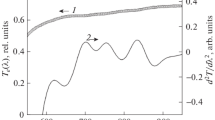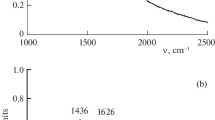Summary
For the first time, the theory of Doppler shifts in thermal scattering of light in birefringent crystals is worked out and the magnitude of the shift Δν of the components is given by\(\Delta v/v = \pm v_e /c)\sqrt {n_i ^2 + n_s ^2 - 2n_s n_s cos \theta } \), where Δν is the frequency of the incident light,c the velocity of light in vacuum,v e , the velocity of the elastic wave effective in scattering andn i andn s are either of the refractive indices of the crystal for the incident and observation directions. Sincen i andn s can each take two values, there are four pairs of values (n i ,n s ) and furtherv e takes three values. Therefore, there mustin general betwelve pairs of Doppler components in the light scattered along a particular direction. The twelve pairs can be divided into four species each with a specific pair of values (n i ,n s ) and consequently specific polarisation character. They can be studied individually by the use of proper polarising devices in the incident and scattered paths. Each species consists of three pairs of components arising from the elastic waves of wavelength\(\lambda _e = \lambda /\sqrt {n_s ^2 + n_s ^2 - 2n_s n_s cos \theta } \), whereλ is the wavelength of the incident light in vacuum and propagated along a specific direction. For any particular species, the scattering must be appropriately regarded as “coherent reflection” or “coherent refraction” of light waves by the effective elastic waves according as cosϑ<n i /n s andn s /n i or cosϑ>n s /n i orn s /n i . There can in general be 3 pairs of Doppler components withfinite shifts in the exactlyforward scattering.
In singly refracting crystals (n s /n i =n s /n s =n) the expression for shift reduces to the familiar expression Δν/ν=±(n s /v e /c)2n sinϑ/2 and in this case there could only be three pairs of Doppler components arising from “specular reflection” of light by elastic waves.
Similar content being viewed by others
References
Bhatia, A. B. and Krishnan, K.S...Proc. Rov. Soc., 1948,192A, 181.
Brillouin, L...Ann. d. Physique, 1922,17, 88.
Gross, E...Compt. Rend. U.R.S.S., 1938,18, 93; 1940,26, 757.
Kastler, A...J. de Chemie. Phy., 1949,46, 40.
Krishnan, R. S...Proc. Ind. Acad. Sci., 1935,1, 717.
Mandelstam, L., Landsberg, G. and Leontowitsch, M...Zeit. f. Phy., 1930,60, 334.
Mueller, H...Proc. Roy. Soc., 1938,166A, 495.
Raman, C. V...Nature, 1922,109, 42.
Szivessy, G. ..Handbuch der Physik,20, 635.
Tamm, I...Zeit. f. Phy., 1930,60, 345.
Author information
Authors and Affiliations
Additional information
Communicated by Prof. R. S. Krishnan,f.a.sc.
Rights and permissions
About this article
Cite this article
Chandrasekharan, V. Thermal scattering of light in crystals. Proc. Indian Acad. Sci. (Math. Sci.) 33, 183 (1951). https://doi.org/10.1007/BF03172203
Received:
DOI: https://doi.org/10.1007/BF03172203




